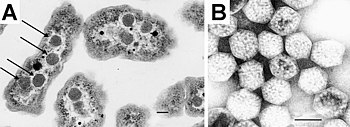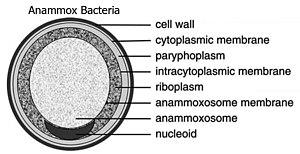କୋଷାଙ୍ଗ
କୋଷଶାସ୍ତ୍ରରେ କୋଷାଙ୍ଗ ବା କୋଷ ଅଙ୍ଗିକା, ଜୀବକୋଷରେ ଥିବା କାର୍ଯ୍ୟରତ କ୍ଷୁଦ୍ର ଗଠନାଦିକୁ ବୁଝାଏ । ଜୀବଶରୀରର ଅଙ୍ଗ ପରି କୋଷ ମଧ୍ଯରେ ରହୁଥିବାରୁ ଏପରି ନାମକରଣ କରାଯାଇଛି । କୋଷାଙ୍ଗଗୁଡ଼ିକ ନିଜସ୍ୱ ମେଦଦ୍ୱିସ୍ତରଦ୍ୱାରା ଘୋଡାଇ ହୋଇ ରହିଥାନ୍ତି (ଝିଲ୍ଲୀ ବିଶିଷ୍ଟ କୋଷାଙ୍ଗ)କିମ୍ବା କୌଣସି ଆବରଣ ବା ଝିଲ୍ଲୀ ବିନା ଉନ୍ମୁକ୍ତ ରହିଥାନ୍ତି (ଝିଲ୍ଲୀ ବିହୀନ କୋଷାଙ୍ଗ) । [ଆଧାର ଲୋଡ଼ା] ଅଧିକାଂଶ କୋଷାଙ୍ଗ କୋଷ ମଧ୍ଯରେ ରହିଥାନ୍ତି, କିନ୍ତୁ କୂଟପାଦ ପରି କେତେକ କୋଷାଙ୍ଗ କୋଷ ବାହାରକୁ ବିସ୍ତାରିଥାନ୍ତି ।[ଆଧାର ଲୋଡ଼ା]
ସୁନ୍ଯଷ୍ଟୀୟ କୋଷରେ ଅନେକ ପ୍ରକାରର କୋଷାଙ୍ଗ ଦେଖାଯାନ୍ତି । ଏଥିରେ କୋଷର ଅନ୍ତର୍ଝିଲ୍ଲୀତନ୍ତ୍ର ଗଠନ କରୁଥିବା ନ୍ଯଷ୍ଟିଝିଲ୍ଲୀ, ଅନ୍ତର୍ଜୀବକ-ଜାଲିକା ଏବଂ ଗୋଲ୍ଗିବୋଡ଼ି ତଥା ମାଇଟୋକଣ୍ଡ୍ରିଆ ଆଦି ଅନ୍ତର୍ଭୁକ୍ତ । ସୁନ୍ଯଷ୍ଟିୟକ ପ୍ରାକ୍-ନ୍ଯଷ୍ଟୀୟ କୋଷରେ ଏହି ସବୁ କୋଷାଙ୍ଗ ନ ଥାଏ, କିନ୍ତୁ କେତେକ କୋଷରେ ପୁଷ୍ଟି-ଖୋଳରେ ଆବୃତ ବ୍ଯାକ୍ଟେରୀୟ ମାଇକ୍ରୋପ୍ରକୋଷ୍ଠ ଦେଖାଯାଏ । ଏଗୁଡିକୁ ପ୍ରାଥମିକ ପ୍ରାକ୍-ନ୍ଯଷ୍ଟୀୟ କୋଷାଙ୍ଗ ବୋଲି ଧରାଯାଏ ।[୧] ତା ଛଡ଼ା ପ୍ରାକ୍-ନ୍ଯଷ୍ଟୀୟ କୋଷଗୁଡ଼ିକରେ ଅନ୍ୟ ଝିଲ୍ଲୀ-ବିଶିଷ୍ଟ କୋଷାଙ୍ଗ ରହିଥିବାର ମଧ୍ଯ ଦେଖାଯାଏ ।[୨] ପ୍ରାକ୍-ନ୍ଯଷ୍ଟୀୟ କୋଷ ବାହାରେ ଥିବା ଫ୍ଲାଜେଲମ୍, ଏହାର ମୋଟର ତଥା କୋଷ ବାହାରର ପାଇଲସକୁ ମଧ୍ଯ କୋଷାଙ୍ଗ ଭାବେ ଧରାଯାଏ ।
ଇତିହାସ ଏବଂ ନୈରୁକ୍ତଶାସ୍ତ୍ର
[ସମ୍ପାଦନା]ଜୀବବିଜ୍ଞାନରେ, ଜୀବ ଶରୀରରେ ଥିବା ଆବଦ୍ଧ କାର୍ଯ୍ୟଭିତ୍ତିକ ଏକକକୁ ଅଙ୍ଗ କୁହାଯାଏ ।[୩] ଶରୀରାଙ୍ଗ ତଥା କୋଷାଙ୍ଗ ମଧ୍ଯରେ ଥିବା ଏହି ସାମଞ୍ଜସ୍ୟ କାରଣରୁ ତାକୁ କୋଷମାନଙ୍କର ଅଙ୍ଗ ବୋଲି ନାମିତ କରାଗଲା ।
୧୮୩୦ ମସିହାରେ, ଫେଲିକ୍ସ୍ ଡୁଜାର୍ଡିନ, ଏଃରେନ୍ ବର୍ଗ୍-ଙ୍କ ସିଦ୍ଧାନ୍ତକୁ ପ୍ରତ୍ଯାଖ୍ଯାନ କଲେ, ଯାହା କହୁଥିଲା- ଅଣୁଜୀବମାନଙ୍କର ଅନ୍ୟ ବୃହତ୍-ଜୀବମାନଙ୍କ ପରି କ୍ଷୁଦ୍ରାକାର ଅଙ୍ଗ ରହିଥାଏ ।
ପ୍ରକାର
[ସମ୍ପାଦନା]ଅଧିକାଂଶ କୋଷବିଜ୍ଞାନୀ କୋଷାଙ୍ଗ ଏବଂ କୋଷ-ପ୍ରକୋଷ୍ଠ ମଧ୍ଯରେ କୌଣସି ପାର୍ଥକ୍ଯ ରଖନ୍ତି ନାହିଁ । କିନ୍ତୁ କେତେକ କୋଷବିଜ୍ଞାନୀଙ୍କ ମତରେ ଅନ୍ତର୍ସହଜୀବୀତାଦ୍ୱାରା ପ୍ରାପ୍ତ ପୂର୍ବ ସ୍ୱାଧୀନ ଅଣୁଜୀବ ଯାହା ବର୍ତ୍ତମାନ କୋଷ ମଧ୍ଯରେ କୋଷର ଏକ ଭାଗ ହୋଇ ରହିଛନ୍ତି ଯାହାଙ୍କ ପାଖରେ DNA ରହିଛି, କେବଳ ସେହିମାନେ କୋଷାଙ୍ଗ ପଦବାଚ୍ଯ ।[୪][୫][୬]
ଏହି ସଜ୍ଞାଧାରରେ କେବଳ ଦୁଇଟି କୋଷାଙ୍ଗ-ଗୋଷ୍ଠୀ ନିରୂପିତ ହୋଇପାରେ, ଯଥା -
(କ) ମାଇଟୋକଣ୍ଡ୍ରିଆ, ଯାହା ସମସ୍ତ ସୁନ୍ଯଷ୍ଟୀୟକଙ୍କଠାରେ ଦେଖାଯାଏ; ଏବଂ
(ଖ) ଲବକ[୭], ଯାହା କେବଳ ସ୍ୱଭୋଜୀଙ୍କଠାରେ ଦେଖାଯାଏ ।
କୋଷାଙ୍ଗର ଆଉ ଏକ ସଜ୍ଞା ହେଲା- ଏମାନେ କୋଷ ମଧ୍ଯରେ ଥିବା ଝିଲ୍ଲୀ-ବିଶିଷ୍ଟ ସଂରଚନା । ଏହି ସଜ୍ଞାଧାରରେ ମଧ୍ଯ ରାଇବୋଜୋମ୍ ଭଳି ସ୍ୱତନ୍ତ୍ର କାର୍ଯ୍ୟ କରୁଥିବା କେତେକ ସଂରଚନା କୋଷାଙ୍ଗ ବୋଲି ଗଣାଯାଇପାରିଲେ ନାହିଁ । କିନ୍ତୁ ରାଇବୋଜୋମ୍ ଭଳି କେତେକ ଝିଲ୍ଲୀ-ବିହୀନ ସଂରଚନା ଆଦିକୁ ସାଧାରଣତଃ କୋଷାଙ୍ଗ ବୋଲି ଧରିନିଆଯାଏ ।[୮][୯][୧୦] ଫଳରେ ଅନେକ ପୁସ୍ତକ ଝିଲ୍ଲୀ-ବିଶିଷ୍ଟ ତଥା ଝିଲ୍ଲୀ-ବିହୀନ କୋଷାଙ୍ଗ ବୋଲି ବର୍ଣ୍ଣନା କରିଥାନ୍ତି ।[୧୧] ଝିଲ୍ଲୀ-ବିହୀନ କୋଷାଙ୍ଗ ବା ବୃହତ୍ ଜୈବାଣବିକ ଯୌଗିକ, ବାସ୍ତବରେ ବୃହଦାଣୁମାନଙ୍କର ସଂଯୋଗ ଅଟନ୍ତି । ଏମାନଙ୍କ ମଧ୍ଯରୁ ଅଧିକାଂଶ ପୁଷ୍ଟିସାରରେ ତିଆରି ହୋଇଥିବାରୁ ପୁଷ୍ଟିସାରୀୟ କୋଷାଙ୍ଗ ବୋଲି ମଧ୍ଯ କୁହାଯାଏ । ଏହିପରି କୋଷାଙ୍ଗଗୁଡ଼ିକ ହେଲେ -
- ବୃହତ୍ RNA ଏବଂ ପୁଷ୍ଟିସାରୀୟ ଯୌଗିକ : ଯଥା- ରାଇବୋଜୋମ୍, ସ୍ପ୍ଲାଇସିଓଜୋମ୍, ଭଲ୍ଟ,
- ବୃହତ୍ ପୁଷ୍ଟୀ-ଯୌଗିକପୁଷ୍ଟୀ-ଯୌଗିକ : ଯଥା - ପ୍ରୋଟିଆଜୋମ, ଡିଏନେ ପଲିମରେଜ III ହୋଲୋଏଞ୍ଜାଇମ, ଆରେନେ ପଲିମରେଜ II ହୋଲୋଏଞ୍ଜାଇମ, ସମାର୍ଦ୍ଧୀ ଭୂତୀୟ ଖୋଳ, ଗ୍ରୋଏଲ ଏବଂ ଗ୍ରୋଏସ ଯୌଗିକ, ଝିଲ୍ଲୀୟ ପୁଷ୍ଟୀ-ଯୌଗିକ, ଫୋଟୋତନ୍ତ୍ର I, ଏଟିପି ସିନ୍ଥେଜ
- ବୃହତ୍ ଡିଏନେ ଏବଂ ପୁଷ୍ଟୀ-ଯୌଗିକ : ଯଥା - ନ୍ଯଷ୍ଟୀଓଜୋମ
- ସେଣ୍ଟ୍ରିଓଲ ଏବଂ ମାଇକ୍ରୋନଳୀ ସଂଶ୍ଳେଷଣ କେନ୍ଦ୍ର
- କୋଷକଙ୍କାଳ
- ଫ୍ଲାଜେଲମ
- ନିନ୍ଯଷ୍ଟି
- ଷ୍ଟ୍ରେସ ଗ୍ରାନ୍ଯୁଲ
- ଜନନ କୋଷ ଗ୍ରାନ୍ଯୁଲ
- ସ୍ନାୟବିକ ସ୍ଥାନାନ୍ତରଣ ଗ୍ରାନ୍ଯୁଲ
ଯେଉଁ ପ୍ରକିୟାରେ ଏହି ଝିଲ୍ଲୀ-ବିହୀନ-କୋଷାଙ୍ଗଗୁଡ଼ିକ ତିଆରି ହୁଅନ୍ତି ଏବଂ ନିଜ ସ୍ୱରୂପ ବଜାୟ ରଖନ୍ତି ସେହି ପ୍ରକ୍ରିୟାକୁ ତରଳ-ତରଳ ଅବସ୍ଥା ପୃଥକ୍କୀରଣ ବୋଲି ଧରାଯାଇଛି ।[୧୨]
ସୁନ୍ୟଷ୍ଟୀୟ କୋଷାଙ୍ଗ
[ସମ୍ପାଦନା]ସୁନ୍ଯଷ୍ଟୀୟ କୋଷଗୁଡ଼ିକ ଗଠନ ଦୃଷ୍ଟିରୁ ଜଟିଳ ଅଟନ୍ତି । ବଡ଼ କୋଷାଙ୍ଗ ଯେପରିକି ନ୍ଯଷ୍ଟି ତଥା ରସଧାନୀ, ଆଲୋକୀୟ ଅଣୁବୀକ୍ଷଣ ଯନ୍ତ୍ରରେ ମଧ୍ଯ ଦେଖାଯାନ୍ତି ।
ନିମ୍ନଲିଖିତ ପ୍ରତ୍ୟେକ କୋଷାଙ୍ଗଗୁଡ଼ିକ ସମସ୍ତ ସୁନ୍ଯଷ୍ଟୀୟ କୋଷରେ ନଥାଏ । କେତେକ ଜୀବମାନଙ୍କର ଏପରି କୋଷ ରହିଥାଏ ଯେଉଁଠାରେ ପ୍ରତ୍ଯେକ ସୁନ୍ଯଷ୍ଟୀୟ କୋଷାଙ୍ଗ ନଥାଏ (ଉ.ସ୍ୱ. ମାଇଟୋକଣ୍ଡ୍ରିଆ) ।[୧୩]
| କୋଷାଙ୍ଗ | ମୁଖ୍ଯ କାର୍ଯ୍ୟ | ଗଠନ | ଜୀବଗଣ | ବି.ଦ୍ର. |
|---|---|---|---|---|
| କୋଷଝିଲ୍ଲୀ | କୋଷ ବହିର୍ଦ୍ଦେଶକୁ କୋଷର ଅନ୍ତର୍ଦ୍ଦେଶରୁ ଅଲଗା କରିଥାଏ ଏବଂ କୋଷକୁ ବାହ୍ଯ ପରିବେଶରୁ ରକ୍ଷା କରିଥାଏ । | ଦ୍ୱୈମାତ୍ରିକ ତରଳ | ସମସ୍ତ ସୁନ୍ଯଷ୍ଟୀୟକ | |
| କୋଷଭିତ୍ତି | କୋଷଭିତ୍ତି ପେପ୍ଟିଡୋଗ୍ଲାଇକାନରେ ତିଆରି ହୋଇଥାଏ ଏବଂ ଏହା କଠିନ ଯାହା କୋଷକୁ ଏକ ନିର୍ଦ୍ଦିଷ୍ଟ ଆକାର ଦେଇଥାଏ । | ସେଲ୍ଯୁଲୋଜ | ଉଦ୍ଭିଦ, ପ୍ରୋଟିଷ୍ଟ, ଦୁର୍ଲଭ କ୍ଲେପ୍ଟୋପ୍ଲାଷ୍ଟୀୟ ଜୀବ | |
| ହରିତ୍ ଲବକ (ଲବକ) | ଆଲୋକ ସଂଶ୍ଳେଷଣ, ସୂର୍ଯ୍ୟାଲୋକରୁ ଶକ୍ତି ସଂଗ୍ରହ କରେ | ଦ୍ୱି-ଝିଲ୍ଲୀୟ ପ୍ରକୋଷ୍ଠ | ଉଦ୍ଭିଦ, ପ୍ରୋଟିଷ୍ଟ, ଦୁର୍ଲଭ କ୍ଲେପ୍ଟୋପ୍ଲାଷ୍ଟୀୟ ଜୀବ | ନିଜସ୍ବ ଡିଏନେ ଅଛି; (ଅନ୍ତର୍ସହଜୀବୀତା) |
| ଅନ୍ତର୍ଜୀବକୀୟ ସୂତ୍ର | ନୂଆ ପୁଷ୍ଟି ସଂଶ୍ଳେଷଣ, ମେଦ ପ୍ରକାଶନ | ଏକ-ଝିଲ୍ଲୀୟ ପ୍ରକୋଷ୍ଠ | ସମସ୍ତ ସୁନ୍ଯଷ୍ଟୀୟକ | ଖଦଡ଼ ଅନ୍ତର୍ଜୀବକୀୟ ସୂତ୍ର ରାଇବୋଜୋମଦ୍ୱାରା ଆବୃତ; ମସୃଣ ଅନ୍ତର୍ଜୀବକୀୟ ସୂତ୍ର ପାଖରେ ରାଇବୋଜୋମ ନଥାଏ । |
| ଫ୍ଲାଜେଲମ | ଚଳପ୍ରଚଳ | ପୁଷ୍ଟି | କିଛି ସୁନ୍ଯଷ୍ଟୀୟକ | |
| ଗୋଲ୍ଗୀତନ୍ତ୍ର | ପୁଷ୍ଟିଗୁଡ଼ିକର ପ୍ଯାକିଂ | ଏକ-ଝିଲ୍ଲୀୟ ପ୍ରକୋଷ୍ଠ | ସମସ୍ତ ସୁନ୍ଯଷ୍ଟୀୟକ | |
| ମାଇଟୋକଣ୍ଡ୍ରିଆ | ଶକ୍ତି ଉତ୍ପାଦନ ଏବଂ ଏଟିପି ସଂଶ୍ଳେଷଣ | ଦ୍ୱି-ଝିଲ୍ଲୀୟ ପ୍ରକୋଷ୍ଠ | ଅଧିକାଂଶ ସୁନ୍ଯଷ୍ଟୀୟକ | ନିଜସ୍ବ ଡିଏନେ ଅଛି; (ଅନ୍ତର୍ସହଜୀବୀତା)[୧୪] |
| ନ୍ଯଷ୍ଟି | ଡିଏନେ ନିୟନ୍ତ୍ରଣ, କୋଷର ସମସ୍ତ କାର୍ଯ୍ୟର ନିୟନ୍ତ୍ରଣ, ଆରେନେ ସଂଶ୍ଳେଷଣ | ଦ୍ୱି-ଝିଲ୍ଲୀୟ ପ୍ରକୋଷ୍ଠ | ସମସ୍ତ ସୁନ୍ଯଷ୍ଟୀୟକ | ଜେନୋମ ଧାରକ |
| ରସଧାନୀ | ଭଣ୍ଡାରଣ, ସ୍ଥାନାନ୍ତରଣ | ଏକ-ଝିଲ୍ଲୀୟ ପ୍ରକୋଷ୍ଠ | ସୁନ୍ଯଷ୍ଟୀୟକ |
ଉଭୟ ମାଇଟୋକଣ୍ଡ୍ରିଆ ଏବଂ ଲବକ (ହରିତ୍ ଲବକ)ଙ୍କ ପାଖରେ ଦୁଇଟି ଝିଲ୍ଲୀ ଏବଂ ନିଜସ୍ବ ଡିଏନେ ରହିଛି । ଅନ୍ତର୍ସହଜୀବୀ ଉପପାଦ୍ୟ, ଅନୁସାରେ ଏହି କୋଷାଙ୍ଗ ଦ୍ୱୟ ବାସ୍ତବରେ ପ୍ରାଚୀନ ସୁନ୍ଯଷ୍ଟୀୟ କୋଷରେ ରହିଯାଇଥିବା ପ୍ରାକ୍-ନ୍ଯଷ୍ଟୀୟ ଜୀବ ।
| କୋଷାଙ୍ଗ/ବୃହଦାଣୁ | ମୁଖ୍ଯ କାର୍ଯ୍ୟ | ଗଠନ | ଜୀବ |
|---|---|---|---|
| ଆକ୍ରୋଜୋମ | ଶୁକ୍ରାଣୁର ଡିମ୍ବାଣୁ ସହ ମିଳନରେ ସାହାଯ୍ୟ କରେ | ଏକ ଝିଲ୍ଲୀ ବିଶିଷ୍ଟ ପ୍ରକୋଷ୍ଠ | ଅଧିକାଂଶ ପ୍ରାଣୀ |
| ସ୍ବଫାଗୋଜୋମ | କୋଷଜୀବକୀୟ ପଦାର୍ଥ ତଥା କୋଷାଙ୍ଗ ବିଘଟନ | ଦ୍ୱିଝିଲ୍ଲୀୟ ପ୍ରକୋଷ୍ଠ | ସମସ୍ତ ସୁନ୍ଯଷ୍ଟିୟକ |
| ସେଣ୍ଟ୍ରିଓଲ | କୋଷକଙ୍କାଳ ଧରିବା, କୋଷ ବିଭାଜନ ନିୟନ୍ତ୍ରଣ କରିବା | ମାଇକ୍ରୋନଳୀ ପୁଷ୍ଟିସାର | ପ୍ରାଣୀ |
| ସିଲିଆ | ବାହ୍ଯ ପରିବେଶରେ ଚଳପ୍ରଚଳ;[୧୫] | ମାଇକ୍ରୋନଳୀର ପୁଷ୍ଟି | ପ୍ରାଣୀ, ପ୍ରୋଟିଷ୍ଟା, କେତେକ ଉଦ୍ଭିଦ |
| ନିଡୋସିଷ୍ଟ | ଦଂଶନ | ବୃତ୍ତାକାର ଖୋଳ ନଳୀ | ନିଡାରିଆ |
| ଚକ୍ଷୁବିନ୍ଦୁ ଯନ୍ତ୍ର | ପ୍ରକାଶ ସଂଗ୍ରହ, allowing phototaxis to take place | green algae and other unicellular photosynthetic organisms such as euglenids | |
| glycosome | carries out glycolysis | single-membrane compartment | Some protozoa, such as Trypanosomes. |
| glyoxysome | conversion of fat into sugars | single-membrane compartment | plants |
| hydrogenosome | energy & hydrogen production | double-membrane compartment | a few unicellular eukaryotes |
| lysosome | breakdown of large molecules (e.g., proteins + polysaccharides) | single-membrane compartment | animals |
| melanosome | pigment storage | single-membrane compartment | animals |
| mitosome | probably plays a role in Iron-sulfur cluster (Fe-S) assembly | double-membrane compartment | a few unicellular eukaryotes that lack mitochondria |
| myofibril | myocyte contraction | bundled filaments | animals |
| nucleolus | pre-ribosome production | protein-DNA-RNA | most eukaryotes |
| ocelloid | detects light and possibly shapes, allowing phototaxis to take place | double-membrane compartment | members of the family Warnowiaceae |
| parenthesome | not characterized | not characterized | fungi |
| peroxisome | breakdown of metabolic hydrogen peroxide | single-membrane compartment | all eukaryotes |
| proteasome | degradation of unneeded or damaged proteins by proteolysis | very large protein complex | all eukaryotes, all archaea, and some bacteria |
| ribosome (80S) | translation of RNA into proteins | RNA-protein | all eukaryotes |
| stress granule | mRNA storage[୧୬] | membraneless
(mRNP complexes) |
most eukaryotes |
| TIGER domain | mRNA encoding proteins | membraneless | most organisms |
| vesicle | material transport | single-membrane compartment | all eukaryotes |
ଅନ୍ଯାନ୍ଯ ସମ୍ବନ୍ଧିତ ଗଠନ:
ପ୍ରାକ୍-ନ୍ଯଷ୍ଟୀୟ କୋଷାଙ୍ଗ
[ସମ୍ପାଦନା]

ପ୍ରାକ୍-ନ୍ଯଷ୍ଟୀୟକମାନଙ୍କର ଗଠନ ସୁନ୍ଯଷ୍ଟୀୟକମାନଙ୍କ ପରି ଜଟିଳ ନୁହେଁ । ଏକ ସମୟରେ ପ୍ରାକ୍-ନ୍ଯଷ୍ଟୀୟକମାନଙ୍କର କୌଣସି ଝିଲ୍ଲୀ ବିଶିଷ୍ଟ କୋଷାଙ୍ଗ ନାହିଁ ବୋଲି କଳ୍ପନା କରାଯାଉଥିଲା ।
| କୋଷାଙ୍ଗ/ବୃହଦାଣୁ | ମୁଖ୍ଯ କାର୍ଯ୍ୟ | ଗଠନ | ଜୀବଗଣ |
|---|---|---|---|
| ଆନାମୋକ୍ସୋମ | ଅବାୟବ ଆମୋନିଅମ ଜାରଣ | ଲାଡରେନ ମେଦ-ଝିଲ୍ଲୀ | ପ୍ଲାଙ୍କ୍ଟୋମିସେଟ୍ସର "କ୍ଯାନଡିଡାଟସ" ବୀଜାଣୁ |
| କାର୍ବୋକ୍ସିଜୋମ | ଅଙ୍ଗାର ବିବନ୍ଧନ | ପୁଷ୍ଟି ଖୋଳ ବ୍ଯାକ୍ଟେରୀୟ କ୍ଷୁଦ୍ର-ପ୍ରକୋଷ୍ଠ | କିଛି ବୀଜାଣୁ |
| କ୍ଲୋରୋଜୋମ | ଆଲୋକ ସଂଶ୍ଳେଷଣ | କୋଷଝିଲ୍ଲୀ ଉପରେ ଆଲୋକ ଅମଳ ସଂରଚନା | ହରିତ୍ ଗନ୍ଧକ ବୀଜାଣୁ |
| ଫ୍ଲାଜେଲମ | ବାହ୍ଯ ମାଧ୍ଯମରେ ଚଳପ୍ରଚଳ | ପୁଷ୍ଟି ସୂତା | କିଛି ପ୍ରାକ୍-ନ୍ଯଷ୍ଟୀୟକ ଏବଂ ସୁନ୍ଯଷ୍ଟୀୟକ |
| ଚୁମ୍ବକୋଜୋମ | ଚୁମ୍ବକୀୟ ଅନୁସ୍ଥାପନ | ଅଜୈବୀକ କ୍ରିଷ୍ଟାଲ, ମେଦ-ଝିଲ୍ଲୀ | ମ୍ଯାଗ୍ନେଟୋଟାକ୍ଟୀୟ ବୀଜାଣୁ |
| ନ୍ଯୁକ୍ଲିଓଏଡ | ଡିଏନେ ନିୟନ୍ତ୍ରଣ, ଆରେନେ ସଂଶ୍ଳେଷଣ | ଡିଏନେ-ପୁଷ୍ଟି | ପ୍ରାକ୍-ନ୍ଯଷ୍ଟୀୟକ |
| ପାଇଲସ | କୋଞ୍ଜୁଗେସଣ ପାଇଁ ଅନ୍ଯ କୋଷମାନଙ୍କ ସହ ସଂଯୋଗ ସ୍ଥାପନ | କୋଷଝିଲ୍ଲୀଠାରୁ ବାହାରି ପଡ଼ିଥିବା କେଶପରି ଗଠନ | ପ୍ରାକ୍-ନ୍ଯଷ୍ଟୀୟ କୋଷ |
| ପ୍ଲାଜମିଡ଼ | ଡିଏନେ ଅଦଳବଦଳ | ଚକ୍ରାକାର ଡିଏନେ | କିଛି ବୀଜାଣୁ |
| ରାଇବୋଜୋମ (୭୦S) | ଆରେନେରୁ ପୁଷ୍ଟି ସଂଶ୍ଳେଷଣ | ଆରେନେ-ପୁଷ୍ଟି | ବ୍ଯାକ୍ଟେରୀଆ ଏବଂ ଆର୍କୀଆ |
| ଥାଇଲାକୋଏଡ ଝିଲ୍ଲୀ | ଆଲୋକ ସଂଶ୍ଳେଷଣ | ଫୋଟୋତନ୍ତ୍ରର ପୁଷ୍ଟି ଓ ରଙ୍ଗକଣା | ସିଆନୋବ୍ଯାକ୍ଟେରିଆ |
ଆଧାର
[ସମ୍ପାଦନା]- ↑ Kerfeld CA, Sawaya MR, Tanaka S, Nguyen CV, Phillips M, Beeby M, Yeates TO (August 2005). "Protein structures forming the shell of primitive organelles". Science. 309 (5736): 936–8. Bibcode:2005Sci...309..936K. CiteSeerX 10.1.1.1026.896. doi:10.1126/science.1113397. PMID 16081736.
- ↑ Murat, Dorothee; Byrne, Meghan; Komeili, Arash (2010-10-01). "Cell Biology of Prokaryotic Organelles". Cold Spring Harbor Perspectives in Biology. doi:10.1101/cshperspect.a000422. PMC 2944366. PMID 20739411. Retrieved 2020-07-11.
- ↑ Peterson L (April 17, 2010). "Mastering the Parts of a Cell". Lesson Planet. Retrieved 2010-04-19.
- ↑ Keeling PJ, Archibald JM (April 2008). "Organelle evolution: what's in a name?". Current Biology. 18 (8): R345-7. doi:10.1016/j.cub.2008.02.065. PMID 18430636.
- ↑ Imanian B, Carpenter KJ, Keeling PJ (March–April 2007). "Mitochondrial genome of a tertiary endosymbiont retains genes for electron transport proteins". The Journal of Eukaryotic Microbiology. 54 (2): 146–53. doi:10.1111/j.1550-7408.2007.00245.x. PMID 17403155.
- ↑ Mullins, Christopher (2004). "Theory of Organelle Biogenesis: A Historical Perspective". The Biogenesis of Cellular Organelles. Springer Science+Business Media, National Institutes of Health. ISBN 978-0-306-47990-8.
{{cite book}}: Unknown parameter|name-list-format=ignored (|name-list-style=suggested) (help) - ↑ Alberts, Bruce; Johnson, Alexander; Lewis, Julian; Raff, Martin; Roberts, Keith; Walter, Peter. "The Genetic Systems of Mitochondria and Plastids". Molecular Biology of the Cell (4th ed.). ISBN 978-0-8153-3218-3.
{{cite book}}: Unknown parameter|name-list-format=ignored (|name-list-style=suggested) (help) - ↑ Campbell, Neil A; Reece, Jane B; Mitchell, Lawrence G (2002). Biology (6th ed.). Benjamin Cummings. ISBN 978-0-8053-6624-2.
{{cite book}}: Unknown parameter|name-list-format=ignored (|name-list-style=suggested) (help) - ↑ Nott TJ, Petsalaki E, Farber P, Jervis D, Fussner E, Plochowietz A, Craggs TD, Bazett-Jones DP, Pawson T, Forman-Kay JD, Baldwin AJ (March 2015). "Phase transition of a disordered nuage protein generates environmentally responsive membraneless organelles". Molecular Cell. 57 (5): 936–947. doi:10.1016/j.molcel.2015.01.013. PMC 4352761. PMID 25747659.
- ↑ Banani SF, Lee HO, Hyman AA, Rosen MK (May 2017). "Biomolecular condensates: organizers of cellular biochemistry". Nature Reviews Molecular Cell Biology. 18 (5): 285–298. doi:10.1038/nrm.2017.7. PMC 7434221. PMID 28225081.
- ↑ Cormack DH (1984). Introduction to Histology. Lippincott. ISBN 978-0-397-52114-2.
- ↑ Brangwynne CP, Eckmann CR, Courson DS, Rybarska A, Hoege C, Gharakhani J, Jülicher F, Hyman AA (June 2009). "Germline P granules are liquid droplets that localize by controlled dissolution/condensation". Science. 324 (5935): 1729–32. Bibcode:2009Sci...324.1729B. doi:10.1126/science.1172046. PMID 19460965.
- ↑ Fahey RC, Newton GL, Arrick B, Overdank-Bogart T, Aley SB (April 1984). "Entamoeba histolytica: a eukaryote without glutathione metabolism". Science. 224 (4644): 70–2. Bibcode:1984Sci...224...70F. doi:10.1126/science.6322306. PMID 6322306.
- ↑ Alberts, Bruce; Johnson, Alexander; Lewis, Julian; Morgan, David; Raff, Martin C; Roberts, Keith; Walter, Peter; Wilson, John H; Hunt, Tim (2014-11-18). Molecular biology of the cell (Sixth ed.). Garland Science. p. 679. ISBN 978-0815345244.
{{cite book}}: Unknown parameter|name-list-format=ignored (|name-list-style=suggested) (help) - ↑ Badano JL, Mitsuma N, Beales PL, Katsanis N (September 2006). "The ciliopathies: an emerging class of human genetic disorders". Annual Review of Genomics and Human Genetics. 7: 125–48. doi:10.1146/annurev.genom.7.080505.115610. PMID 16722803.
- ↑ Anderson P, Kedersha N (March 2008). "Stress granules: the Tao of RNA triage". Trends in Biochemical Sciences. 33 (3): 141–50. doi:10.1016/j.tibs.2007.12.003. PMID 18291657.
- ↑ Tsai Y, Sawaya MR, Cannon GC, Cai F, Williams EB, Heinhorst S, Kerfeld CA, Yeates TO (June 2007). "Structural analysis of CsoS1A and the protein shell of the Halothiobacillus neapolitanus carboxysome". PLoS Biology. 5 (6): e144. doi:10.1371/journal.pbio.0050144. PMC 1872035. PMID 17518518.
{{cite journal}}: CS1 maint: unflagged free DOI (link)
| ଏହି ପ୍ରସଙ୍ଗଟି ଅସମ୍ପୂର୍ଣ୍ଣ ଅଟେ । ଆପଣ ଏହାକୁ ସଂପୂର୍ଣ୍ଣ କରି ଉଇକିପିଡ଼ିଆକୁ ସମୃଦ୍ଧ କରିପାରିବେ । |
